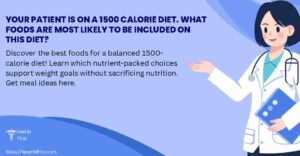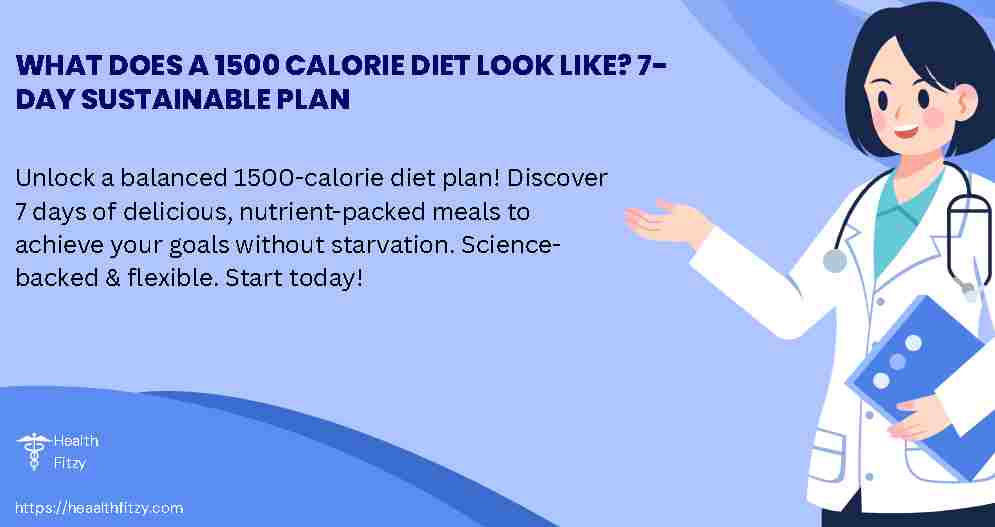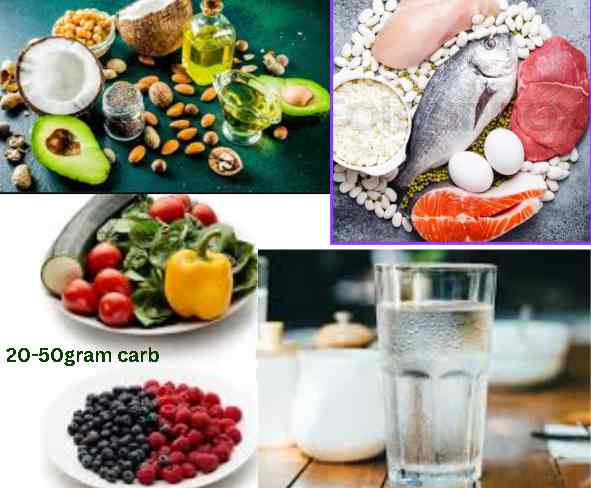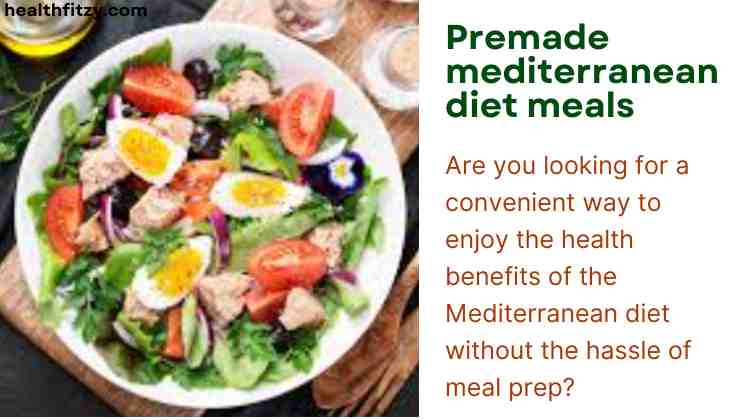What Does a 1500 Calorie Diet Look Like? 7-Day Sustainable Plan
What Does a 1500 Calorie Diet Look Like?
A 1500-calorie diet is a structured eating plan designed for weight management, metabolic health, or sustainable energy. It’s not about deprivation—it’s about strategic balance. This calorie target suits many adults (especially sedentary to moderately active individuals) aiming for gradual weight loss or maintenance. Always consult a doctor before starting any calorie-restricted plan.
Key Principles of a Healthy 1500 Calorie Diet
1. Nutrient Density Over Empty Calories
Prioritize whole foods: vegetables, fruits, lean proteins, whole grains, and healthy fats. Avoid sugary drinks and processed snacks that offer calories without nutrition.
2. Macro Balance Matters
Aim for:
-
50% Calories from Carbs (187g): Focus on fiber-rich oats, quinoa, and berries.
-
25% from Protein (94g): Include eggs, chicken, tofu, or legumes for satiety.
-
25% from Fats (42g): Choose avocado, nuts, and olive oil.
3. Portion Control
Use measuring cups or a food scale initially to avoid underestimating servings.
A Sample Day on a 1500 Calorie Diet plan
Here’s a balanced, flexible day that meets nutritional needs:
Breakfast (350 Calories)
-
2 scrambled eggs with spinach + 1 slice whole-grain toast
-
1 small apple + 1 tbsp almond butter
Lunch (400 Calories)
-
Grilled chicken salad: 3 oz chicken, 2 cups mixed greens, cucumbers, tomatoes
-
¼ avocado + 1 tbsp vinaigrette
-
½ cup chickpeas
Snack (150 Calories)
-
Greek yogurt (½ cup) + ½ cup blueberries
Dinner (450 Calories)
-
4 oz baked salmon
-
¾ cup quinoa
-
1.5 cups roasted broccoli with 1 tsp olive oil
Evening Snack (150 Calories)
-
1 oz mixed nuts
5 Tips for Sustaining a 1500 Calorie Diet plan
-
Hydrate First: Drink water before meals to curb overeating.
-
Plan Ahead: Batch-cook proteins/grains to avoid impulsive choices.
-
Fiber Focus: Include veggies in every meal to stay full longer.
-
Mindful Eating: Slow down; savor each bite to recognize fullness cues.
-
Flexibility: Swap foods within the same calorie/macro group (e.g., fish for tofu, sweet potato for quinoa).
Who Should Avoid This Plan?
A 1500-calorie diet may not suit:
-
Highly active individuals or athletes
-
Pregnant/nursing people
-
Those with diabetes or thyroid issues (without medical guidance).
Final Thoughts
A well-structured 1500-calorie diet emphasizes whole foods, portion awareness, and nutrient timing. It’s not a one-size-fits-all solution—adjust portions based on hunger, energy, and goals. Pair it with light exercise (like walking) for optimal results. For personalized advice, work with a dietitian.
your patient is on a 1500 calorie diet. what foods are most likely to be included on this diet?

Understanding the 1500 Calorie Diet
A 1500 calorie diet plan is a structured eating plan designed to create a calorie deficit for safe, sustainable weight loss or maintenance. It’s often recommended for moderately active adults or those with weight management goals. The key to success lies in prioritizing nutrient-dense, low-calorie foods that maximize vitamins, minerals, and fiber while minimizing empty calories. This approach ensures you stay full, energized, and nourished.
Core Foods in a Balanced 1500 Calorie Diet
These food groups form the foundation of a healthy 1500 calorie diet plan, emphasizing volume, protein, and fiber to combat hunger:
🥬 Non-Starchy Vegetables (Unlimited Emphasis)
Fill half your plate!
-
Leafy greens: Spinach, kale, arugula
-
Cruciferous veggies: Broccoli, cauliflower, Brussels sprouts
-
Hydrating choices: Cucumbers, zucchini, bell peppers, tomatoes
Why they’re included: Extremely low in calories but high in fiber, vitamins (A, C, K), and antioxidants. They add bulk to meals without excess calories.
🥚 Lean Proteins (20-30% of Calories)
Prioritize at every meal for satiety.
-
Poultry/Fish: Skinless chicken breast, turkey, salmon, cod
-
Plant-based: Tofu, tempeh, lentils, chickpeas
-
Low-fat dairy: Greek yogurt, cottage cheese, eggs
Why they’re included: Protein stabilizes blood sugar, preserves muscle mass during weight loss, and keeps you fuller longer than carbs or fats.
🌾 Whole Grains & Starchy Veggies (Moderate Portions)
Focus on fiber-rich, complex carbs.
-
Grains: Oats, quinoa, brown rice, barley
-
Starchy veggies: Sweet potatoes, butternut squash, peas
-
Legumes: Black beans, kidney beans (count as carb + protein!)
Why they’re included: They provide sustained energy, B vitamins, and fiber. Portion control (½ cup cooked) prevents calorie overload.
🥑 Healthy Fats (15-20% of Calories)
Small amounts add flavor and nutrients.
-
Unsaturated oils: Olive oil, avocado oil (1 tsp per serving)
-
Seeds & nuts: Chia seeds, almonds, walnuts (1 tbsp seeds or 10-12 nuts)
-
Avocado: 1/4 fruit per meal
Why they’re included: Fats support hormone health and nutrient absorption. Strict portioning is vital—they’re calorie-dense!
� Low-Calorie Fruits (2-3 Servings Daily)
Nature’s sweet treat.
-
Berries: Strawberries, blueberries, raspberries (1 cup)
-
High-water fruits: Watermelon, cantaloupe, oranges
-
Portable snacks: Apples, pears
Why they’re included: Fruits offer vitamins and fiber, but their natural sugars require mindful portions. Berries are lowest in calories.
Foods to Limit or Avoid
To stay within 1500 calories, minimize:
-
Added sugars: Sodas, candy, pastries
-
Refined carbs: White bread, pasta, sugary cereals
-
Fried foods: Chips, fries, fried meats
-
High-fat meats: Bacon, sausage, ribeye steak
Sample 1500 Calorie diet
Here’s how these foods fit into a balanced day:
-
Breakfast (350 cal): 1 cup Greek yogurt + ½ cup berries + 1 tbsp chia seeds
-
Lunch (400 cal): Large salad with 3 oz grilled chicken, 2 cups greens, veggies, 1 tsp olive oil dressing
-
Snack (150 cal): 1 medium apple + 10 almonds
-
Dinner (450 cal): 4 oz baked salmon + 1 cup roasted broccoli + ½ cup quinoa
-
Dessert (150 cal): 1 cup sliced strawberries
Key Tips for Success
-
Hydrate smartly: Drink water/herbal tea instead of juice or soda.
-
Track portions: Use a food scale or measuring cups initially.
-
Prioritize fiber: Aim for 25–30g daily from veggies, fruits, and grains.
-
Cook at home: Control oils, sauces, and added sugars.
-
Listen to your body: Adjust portions if you’re constantly hungry or fatigued.
Final Thoughts
A 1500 calorie diet plan thrives on whole, minimally processed foods—vegetables, lean proteins, whole grains, and controlled healthy fats. By emphasizing volume and nutrition, you’ll manage hunger effectively while meeting health goals. Always consult a doctor or dietitian before starting any calorie-restricted plan, especially if you have underlying health conditions.
Sustainable weight management isn’t about deprivation—it’s about smart, satisfying choices! 🌱
What is a healthy diebetic diet? Your Guide to Balanced Blood Sugar Eating




Pingback: Printable 1200 Calorie Diet: Smart 7-Day Plan for Effortless Weight Loss!